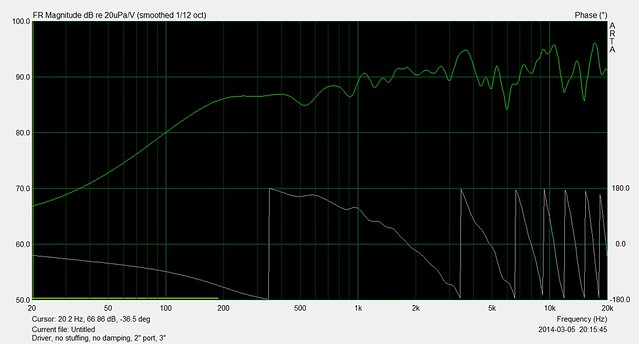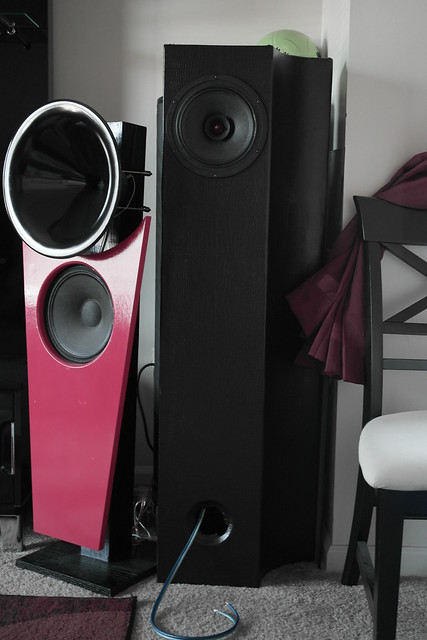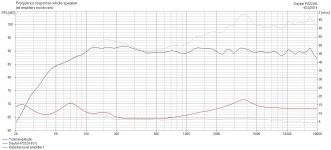So I bought these PS220-8s off of a forum member much too long ago and have just now started building a cabinet for them. After much debate, sketching, research, simulations, research, sketching, etc - I decided on a MLTL.
With some help from Martin J. King's MathCad worksheets I came up with the following:

46.5" interior height, 2 cuft volume (~56.5L), driver about 6 inches down, port about 6" up, 3" dia/2" long port.
Initial sketches came up with this:

I figured the shape was do able... using sonotubes I had no intention of kerfing MDF or ply, although I'm sure it would have saved my some headache later.
I had no intention of kerfing MDF or ply, although I'm sure it would have saved my some headache later.
The initial prototype came out looking alright and couldn't help myself -painters tape is definitely NOT the best way to hold a driver.

Initial impressions - super shouty! Pretty much unbearable to listen to. Just for kicks, I took a quick impulse measurement:

After putting the last of my on hand stuffing I got this (ignore the SPL, I accidentally messed with various volumes in between measurements):

Much better, but definitely still lacking in the bass department. Notice, this was without any filtering at all, no BSC, no notch, etc.
After running some calculations for a BSC, I came up with some numbers that I had some parts for - 3.5mH, 8.2Ohms. This really brought the bass performance up a bit and helped level the top end out quite a bit. I feel that I still need a bit deeper BSC circuit. I'm thinking 4.36mH with ~10Ohms may do it, but sadly I do not have the parts on hand currently.
Of course - I haven't accomplished another measurement yet. More work needed to be done. The sides were just one layer of sonotube and two layers of asphalt felt for damping. The felt did a pretty good job, but I decided to throw on two layers of fiberglass over the top.

Man I hate fiberglass!! But the result was exactly what I desired - increased wall strength. The knock test is pretty good now. After hitting the high spots with the orbital, I added another layer of the asphalt felt to give me some more damping and a smooth surface to work with, as these would end up getting wrapped in some pleather.
During our run to the store today (JoAnn's and Hancock Fabrics), we couldn't find any black vinyl that had that subtle leather feeling to it. We found a few darker browns, however just not what thought would look nice. Well, except for one

That's right - faux alligator My wife was a little iffy about my choice at first, however after wrapping the "thing" she was in love - score!
My wife was a little iffy about my choice at first, however after wrapping the "thing" she was in love - score!


There's still a little work to be done finishing the speaker, mainly top and bottom plates (1" ball bearings for "spikes"), but for now I am enjoying the one in mono. After adding a bit more stuffing (picked up a few days before), solidly mounting the Dayton to the baffle, and adding a +4 bass boost on the receiver I am almost completely happy
Ben K.
With some help from Martin J. King's MathCad worksheets I came up with the following:

46.5" interior height, 2 cuft volume (~56.5L), driver about 6 inches down, port about 6" up, 3" dia/2" long port.
Initial sketches came up with this:

I figured the shape was do able... using sonotubes
The initial prototype came out looking alright and couldn't help myself -painters tape is definitely NOT the best way to hold a driver.

Initial impressions - super shouty! Pretty much unbearable to listen to. Just for kicks, I took a quick impulse measurement:

After putting the last of my on hand stuffing I got this (ignore the SPL, I accidentally messed with various volumes in between measurements):

Much better, but definitely still lacking in the bass department. Notice, this was without any filtering at all, no BSC, no notch, etc.
After running some calculations for a BSC, I came up with some numbers that I had some parts for - 3.5mH, 8.2Ohms. This really brought the bass performance up a bit and helped level the top end out quite a bit. I feel that I still need a bit deeper BSC circuit. I'm thinking 4.36mH with ~10Ohms may do it, but sadly I do not have the parts on hand currently.
Of course - I haven't accomplished another measurement yet. More work needed to be done. The sides were just one layer of sonotube and two layers of asphalt felt for damping. The felt did a pretty good job, but I decided to throw on two layers of fiberglass over the top.

Man I hate fiberglass!! But the result was exactly what I desired - increased wall strength. The knock test is pretty good now. After hitting the high spots with the orbital, I added another layer of the asphalt felt to give me some more damping and a smooth surface to work with, as these would end up getting wrapped in some pleather.
During our run to the store today (JoAnn's and Hancock Fabrics), we couldn't find any black vinyl that had that subtle leather feeling to it. We found a few darker browns, however just not what thought would look nice. Well, except for one

That's right - faux alligator


There's still a little work to be done finishing the speaker, mainly top and bottom plates (1" ball bearings for "spikes"), but for now I am enjoying the one in mono. After adding a bit more stuffing (picked up a few days before), solidly mounting the Dayton to the baffle, and adding a +4 bass boost on the receiver I am almost completely happy
Ben K.
Absolutely. In fact, I already had - multiple times. I don't think the filter network for the Singularities will do it for me, just personal taste. But I may give it a try.
EDIT: The biggest difference between the Singularities and mine is the interior volume. Mine is about 40% of Curt's build. That may have quite a bit to do with what I'm hearing/not hearing.
EDIT: The biggest difference between the Singularities and mine is the interior volume. Mine is about 40% of Curt's build. That may have quite a bit to do with what I'm hearing/not hearing.
Finally someone with a PS220 build! Neat idea with the sonotube and horn cross section. Kind of like a short Nautaloss translated along the height. Did you make any more measurements after sealing it properly? It should have more bass extension than 100 Hz. Nice alligator covering! 
You might be interested in this with the ps220: http://www.diyaudio.com/forums/full-range/227460-fh3-inspired-foam-core-mini-build-8.html#post3843205
Got a few more measurements tonight after dinner. In all cases, the bass boost on the receiver was set to +4 and the 3.5mH/8.2Ohm filter was in place. Pay no attention to the actual SPL levels as again I adjusted volume between tests - the high-end of the driver overpowered the mic after I had already completed the port measurements and didn't want to redo them.
Port output @1in, impulse measurement:

Port output @1in, spectrum analyzer:

Driver output @1ft, impulse measurement:

I tried a much closer measurement of the driver, but saw a huge dip around 5kHz which went away with an increase in mic->driver distance.
The speaker actually measured much flatter than I thought it would, including the up tilt in the bottom octaves. I think my ears are used to much more bass output from the 21" OB woofers...
I may still play around with the filter some, including maybe a slight notch at around 3.5kHz and seeing if anything can be done about the output above 10kHz - but still pretty happy for now.
Also: Taking away the +4 boost, lowers the output below ~250-300Hz by a pretty accurate 4dB - still a bit above the remainder of the range.
Ben K.
Port output @1in, impulse measurement:

Port output @1in, spectrum analyzer:

Driver output @1ft, impulse measurement:

I tried a much closer measurement of the driver, but saw a huge dip around 5kHz which went away with an increase in mic->driver distance.
The speaker actually measured much flatter than I thought it would, including the up tilt in the bottom octaves. I think my ears are used to much more bass output from the 21" OB woofers...
I may still play around with the filter some, including maybe a slight notch at around 3.5kHz and seeing if anything can be done about the output above 10kHz - but still pretty happy for now.
Also: Taking away the +4 boost, lowers the output below ~250-300Hz by a pretty accurate 4dB - still a bit above the remainder of the range.
Ben K.
Ben,
Very nice measurements - the bass extension and smoothness of the frequency response look great. Do you have HD plots to show? Also do you have more listening impressions of the sound? As you know, there are very builds with this driver and even fewer with measurements.
Thanks,
X
Very nice measurements - the bass extension and smoothness of the frequency response look great. Do you have HD plots to show? Also do you have more listening impressions of the sound? As you know, there are very builds with this driver and even fewer with measurements.
Thanks,
X
Hi X,
Hopefully this link will work for you. Dayton PS220-8 MLTL - a set on Flickr
After I finish the second one I'll be able to post more about how they sound. I'll still play with the BSC some whenever I next order a few parts.
Ben K.
EDIT: I just noticed I forgot to add in the phase measurements to the latest graphs...
Hopefully this link will work for you. Dayton PS220-8 MLTL - a set on Flickr
After I finish the second one I'll be able to post more about how they sound. I'll still play with the BSC some whenever I next order a few parts.
Ben K.
EDIT: I just noticed I forgot to add in the phase measurements to the latest graphs...
Fran - that's the mid/tweeter section of my OB setup - more information is in this thread: http://www.diyaudio.com/forums/multi-way/210837-new-forum-member-new-ob-project-9.html
Posts after 89 are regarding the red baffled setup. The hanging 21's are prior to that.
Cheers,
Ben K.
Posts after 89 are regarding the red baffled setup. The hanging 21's are prior to that.
Cheers,
Ben K.
here's some interesting stuff on a PS220 open baffle setup AudioRoundTable.com: Speaker => Dayton Audio/Eminence Full Range Single Driver
FredT's 9uF 0.2mH 12R notch filter for PS220 might be of use http://techtalk.parts-express.com/s...a-15A-H-Frame-Open-Back&p=1899965#post1899965
FredT's 9uF 0.2mH 12R notch filter for PS220 might be of use http://techtalk.parts-express.com/s...a-15A-H-Frame-Open-Back&p=1899965#post1899965
Last edited:
Finalizing
Sorry it's taken so long folks.
I got very acquainted with Boxsim about a week ago and decided to throw the Dayton's through the program to see what I could come up with. I padded the top end down, brought down the peak at around 3.7k, and took the baffle step down quite a bit - maybe a bit too much, but nothing I can't play with.
I built the circuit today and must say that I really like what I hear. Obviously much efficiency was lost, but as it was all in the top end, I feel that they were never that efficient to begin with. They have very adequate bass response now and they still have that little bit of sparkle at the top end. The mids are much improved as well and not as drowned out.
I'm a happy camper
Sorry it's taken so long folks.
I got very acquainted with Boxsim about a week ago and decided to throw the Dayton's through the program to see what I could come up with. I padded the top end down, brought down the peak at around 3.7k, and took the baffle step down quite a bit - maybe a bit too much, but nothing I can't play with.
I built the circuit today and must say that I really like what I hear. Obviously much efficiency was lost, but as it was all in the top end, I feel that they were never that efficient to begin with. They have very adequate bass response now and they still have that little bit of sparkle at the top end. The mids are much improved as well and not as drowned out.
I'm a happy camper
Attachments
- Status
- This old topic is closed. If you want to reopen this topic, contact a moderator using the "Report Post" button.
- Home
- Loudspeakers
- Full Range
- Dayton PS220-8 MLTL Build

